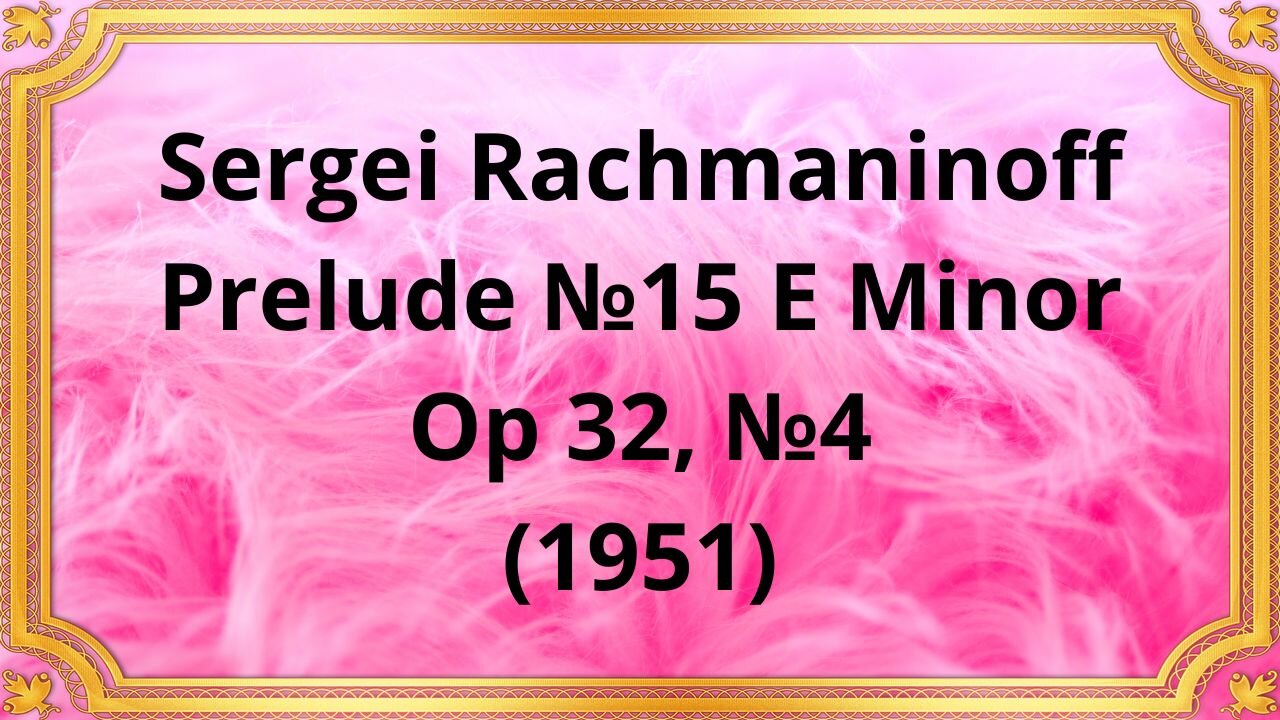Premium Only Content

Sergei Rachmaninoff Prelude №15 E Minor, Op 32, №4 (1951)
#SergeiRachmaninoff #classicalmusic #musicalcomposition #PreludeNo15EMinor #Op32No4 #piano #Russiancomposer #Romanticera #virtuosity #emotionaldepth #musicalinterpretation #musicappreciation #musictheory #classicalpiano #musicalgenius #musicperformance #musiccomposition
Publication date 1951
Dame Moura Lympany
Sergei Rachmaninoff, a renowned Russian composer of the Romantic era, gifted the world with a plethora of emotionally charged and technically demanding compositions. Among his notable works, Prelude No. 15 in E Minor, Op 32, No. 4 stands as a testament to his extraordinary musical prowess and ability to create profound musical landscapes.
Prelude No. 15 in E Minor, Op 32, No. 4 is a solo piano composition that exemplifies Rachmaninoff's characteristic style. Composed in 1910, it forms part of his collection of Preludes, each offering its own unique musical journey. This particular prelude is known for its brooding intensity and powerful emotions that Rachmaninoff skillfully embeds within the piece.
One of the defining features of Prelude No. 15 is its raw intensity and emotional depth. The composition immerses the listener in a world of profound melancholy and tumultuous emotions. From the very first notes, Rachmaninoff creates a sense of urgency and drama, building tension that continues to escalate throughout the piece. The expressive power of this prelude lies in its ability to evoke a range of emotions, from sorrow and anguish to moments of fleeting hope.
Rachmaninoff's Prelude No. 15 showcases his virtuosic piano writing and demands exceptional technical skill from the performer. The composition features rapid passages, intricate hand crossings, and bold chordal sequences that require precise execution and dexterity. The virtuosic elements heighten the intensity of the composition, adding to its dramatic impact and showcasing Rachmaninoff's mastery as a composer.
The harmonic language of Prelude No. 15 is characterized by Rachmaninoff's use of rich and evocative chords. He weaves together dissonance and resolution, creating a sense of tension and release that adds to the emotional impact of the piece. The musical structure follows a ternary form, with an opening section that introduces the main theme, followed by a contrasting middle section, and concluding with a return to the initial material. This structure enhances the overall narrative and showcases Rachmaninoff's skillful compositional technique.
Prelude No. 15 E Minor has left an indelible mark on the classical music world. Its intense emotions, technical demands, and expressive power have made it a staple in the repertoire of pianists and a favorite among audiences. The piece's enduring popularity serves as a testament to Rachmaninoff's ability to connect with listeners on a deep emotional level and has contributed to his status as one of the greatest composers of his time.
Sergei Rachmaninoff's Prelude No. 15 E Minor, Op 32, No. 4 is a musical work that continues to captivate audiences with its intense emotions, virtuosic elements, and expressive power. Through its brooding intensity and technical demands, this composition showcases Rachmaninoff's exceptional talent as a composer, leaving a lasting impression on all who experience it. Prelude No. 15 stands as a testament to the enduring legacy of Sergei Rachmaninoff in the realm of classical music, inspiring and captivating generations of musicians and music lovers alike.
You have the opportunity to support the channel:
https://destream.net/live/RadSiarAl/donate
https://www.buymeacoffee.com/6355radsiaral
-
 2:08:48
2:08:48
TheSaltyCracker
8 hours agoLefty Grifters Go MAGA ReeEEeE Stream 12-22-24
157K451 -
 1:15:40
1:15:40
Man in America
11 hours agoThe DISTURBING Truth: How Seed Oils, the Vatican, and Procter & Gamble Are Connected w/ Dan Lyons
65.5K42 -
 6:46:07
6:46:07
Rance's Gaming Corner
13 hours agoTime for some RUMBLE FPS!! Get in here.. w/Fragniac
139K1 -
 1:30:48
1:30:48
Josh Pate's College Football Show
12 hours ago $6.25 earnedCFP Reaction Special | Early Quarterfinal Thoughts | Transfer Portal Intel | Fixing The Playoff
49.4K -
 23:55
23:55
CartierFamily
3 days agoElon & Vivek TRIGGER Congress as DOGE SHUTS DOWN Government
123K152 -
 5:43:44
5:43:44
Scammer Payback
2 days agoCalling Scammers Live
198K26 -
 18:38
18:38
VSiNLive
2 days agoProfessional Gambler Steve Fezzik LOVES this UNDERVALUED Point Spread!
145K17 -
 LIVE
LIVE
Right Side Broadcasting Network
10 days agoLIVE REPLAY: President Donald J. Trump Keynotes TPUSA’s AmFest 2024 Conference - 12/22/24
2,541 watching -
 4:31
4:31
CoachTY
1 day ago $28.43 earnedCOINBASE AND DESCI !!!!
187K11 -
 10:02
10:02
MichaelBisping
1 day agoBISPING: "Was FURY ROBBED?!" | Oleksandr Usyk vs Tyson Fury 2 INSTANT REACTION
107K14